出处:Planetarian, 2016, 45(4)
标题:Filmmaking for Fulldome: Best Practices and Guidelines for Immersive Cinema (Part I)
作者:Ka Chun Yu, Dan Neafus, Ryan Wyatt
翻译:Horace Lu
(注:键盘快捷键“w”或左侧菜单右上角按钮,可切换文章列表视图与大纲视图)
- Introduction 简介
- Fulldome attributes 全景球幕的属性
- Frames for a frameless medium 无框媒介的边框
- Slowing action for giant screens 放慢巨幕电影的动作
- Pacing of theatrical features, IMAX® 影院长片与 IMAX® 影片的节奏
- The Pacing of fulldome films 全景球幕电影的节奏
- A Theory of Immersive Cinema 沉浸式电影理论
- Camera Reveals and Hiding Edits 镜头揭示与隐藏剪辑
- Coming next 下篇预告
- Acknowledgments 致谢
- References 参考文献
Introduction 简介
Over a century of cinematic history has produced not only an enormous catalogue of films, but also a rich understanding of how this medium has embedded itself into our cultural landscape. The historical, sociological, and economic reasons for the rise of moviegoing are well documented (e.g., Schatz 1996; Thompson & Bordwell 2009). However, narrative filmmaking also has become as successful as it is today because filmmakers discovered ways to engage viewers with visual storytelling. How we perceive and interpret not only simple visual elements - such as light, shape, and color, but also the more complex interplay of these inside the two-dimensional frame and within three-dimensional spaces—help shape the aesthetics of cinema, and, in turn, communicate information and emotions (Zettl 1998).
在超过一个世纪的电影史中,不仅有大量的影片生产出来,我们对电影如何融入文化景观的理解也在加深。关于电影观影兴起的历史、社会和经济原因,有很多详细的记录(如 Schatz 1996,Thompson & Bordwell 2009)。然而,叙事电影之所以能取得今天的成功,还在于电影制作者找到了通过视觉叙事来吸引观众的方法。我们对光、形状、颜色等简单视觉元素的感知和解释,以及这些元素在二维画面和三维空间中的复杂互动,塑造了电影的美学,进而帮助电影传达信息和情感(Zettl 1998)。
Master filmmakers understand how to combine and link such elements into a visual structure that supports a story throughout a film (Block 2008). Audiences are drawn to cinematic entertainment (as well as its artistic descendants such as television), in part, because of the effectiveness of the visuals in adding to the experience.
杰出的电影制片人懂得如何将以上各种元素组合起来,链接成一套贯穿整部电影的视觉结构(Block 2008)。观众被电影这种娱乐形式(及其艺术上的后裔如电视)吸引的部分原因就在于,视觉元素(visuals)的有效性增强了观影体验。
Fulldome cinema is another offspring of traditional cinema, with antecedents in the OMNIMAX® (now IMAX Dome®) films of the 1970 s and 1980s, but whose flowering as a medium only began after the turn of this century. Although rooted in flat screen film, the fulldome medium has unique attributes that suggest different rules for effective storytelling. Informal guidelines have been adopted by fulldome filmmakers, but so far, to the best of our knowledge, these have not been codified.
全景球幕电影(fulldome cinema)是传统电影的另一种延伸形式,其前身是 20 世纪 70~80 年代的 OMNIMAX®(现称 IMAX Dome®)电影,但其作为一种媒介的真正发展是在本世纪初才开始的。尽管起源于平面银幕电影,全景球幕电影却有着独特的属性,这意味着它有不同的叙事规则。全景球幕电影人采用了一些非正式的指导原则来制作球幕影片,但据我们所知,这些原则还没有得到系统化的梳理。
In this first of a two-part paper, we make an initial attempt at doing so by reviewing past precepts and identifying our own prescriptions. We describe the critical ways in which the fulldome medium is different from traditional film and what that means for the filmmaker. We briefly illustrate the history of pacing in feature Hollywood films, giant screen cinema, and fulldome films; how they have evolved over time; and their consequences for filmmaking. If we accept that fulldome films are a type of immersive cinema in which the audience feels they are experiencing what is shown on screen, then it is possible to create a new theoretical framework of cinematic language and techniques which parallel those in traditional framed film. We outline the key elements of such a system of thinking, and show some examples from films that accommodate this theory. Finally, a dome display gives more directions where visual content can show up; viewers can miss critical on-screen information if they gaze in the wrong direction at the wrong time.
在这篇分两部分的论文的第一部分中,我们试图回顾过去的不成文原则,并提出我们自己的建议,初步尝试对这些原则进行系统化。我们描述了全景球幕电影与传统电影的关键区别,以及这些区别对电影人的意义。我们简要介绍了好莱坞剧情片、大银幕电影和全景球幕电影的叙事节奏(pacing)发展历史,介绍了它们如何随着时间演变,并总结了这些变化对电影制作的影响。如果我们认为全景球幕电影是一种沉浸式电影,即观众感觉自己是在亲身体验银幕上的内容,那么我们可以比照传统的带有画框的电影,建立一套针对球幕的全新电影语言和技术理论框架。我们概述了这种思维体系的关键要素,并介绍了一些符合这一理论的影片的例子。最后,球幕银幕的形态使得视觉内容呈现的方向增加,如果观众在错误的时间朝错误的方向观看,他们可能会错过关键信息。
In Part II of this paper, we will identify directorial choices about what and how content is shown in order to mitigate this problem.
在论文的第二部分中,我们将探讨导演在展示内容时如何进行艺术抉择,以减少上述问题。
In both parts of this paper, we use actual sequences from fulldome films as examples for our analyses, and show frames from them to illustrate our points. Although there are many shows and producers that could have been highlighted, we chose films that we could carefully view while researching this paper, and hence represent a small but (we hope) representative fraction of all produced films.
在论文的两部分中,我们使用全景球幕电影中的实际片段作为分析示例,并展示其中的特定静帧来说明我们的观点。尽管有许多影片和制作人值得重点关注,但我们选择的例子是在撰写本文时可以仔细观看研究的影片,因此仅代表了所有球幕影片中的一小部分(我们希望它们足够具有代表性)。
Note that we are not attempting to describe how a filmmaker should work. We make no recommendations about what camera equipment or any other hardware to use, nor do we describe any modeling and animation software, nor any detailed production pipelines. The two papers in this series will describe a few useful tools that will impact how a production proceeds, but their primary goal is to get directors and producers to consider why visuals work the way they do in fulldome, and to think about structuring their shotswhether live action or computer-generated to create the greatest impact for the story they wish to tell.
请注意,我们并不是在试图描述电影人应该如何工作。我们在这里不做摄影机或硬件的使用推荐,也不描述任何建模和动画软件,不介绍详细的生产流程。本系列的两篇论文会介绍一些对制作过程有所帮助的工具,但文章的主要目标还是让导演和制片人思考全景球幕中的视觉元素是如何产生效果的,并思考如何设计他们的镜头,无论是实景拍摄还是计算机生成镜头,以期对叙事产生最有利的影响。
Fulldome attributes 全景球幕的属性

Figure 1: Profile views of a (a) level fulldome theater, (b) a tilted fulldome theater, and (c) a giant screen theater. Unless specified otherwise, all illustrations by authors.
图 1:(a) 水平全景球幕影院 (b) 倾斜全景球幕影院 (c) 巨幕影院 的资料图片,如无特殊声明,均为作者绘制
Fulldome cinema in domed theaters is a very different medium than traditional cinema: instead of projections on a flat screen in front of the audience, the hemispherical display surrounds the viewers, immersing them in imagery and sounds. Depending on whether the theater is level like a traditional planetarium (Fig. 1a), or is tilted with seats placed at an incline (Fig. 1b), audience members have their visual fields filled by the dome. In fact, unlike a traditional theater, imagery can extend to 180° in both the horizontal and vertical directions, far beyond what the viewer can take in at once.
在球幕影院(domed theaters)中,全景球幕电影的表现与传统电影有很大不同:图像不再投影在观众前方的平面银幕上,而是投射在将观众包围的半球形银幕上,使观众完全沉浸在画面和声音中。球幕影院可以像传统天文馆一样呈水平形态(图 1a),或者呈座位倾斜的姿态(图 1b),在两种形态下观众的视野都会被球幕填满。实际上,与传统影院不同的是,全景球幕的影像可以在水平和垂直方向上扩展到 180°,远远超出观众在单一时刻所能看到的范围。
By comparison, an IMAX® screen (Fig. 1c) fills a lateral field-of-view (FOV) of 60° to 120°, and a 40° to 80° vertical field, while the hemispherical OMNIMAX® expands on this to 180° laterally but only 130° vertically (Shaw & Douglas 1983).
相比之下,IMAX® 银幕(图 1c)只能覆盖 60° 到 120° 的横向视野和 40° 到 80° 的垂直视野,而半球形的 OMNIMAX® 银幕虽然在横向上可以扩展到 180°,但垂直方向只有 130°(Shaw & Douglas 1983)。
Having such an expansive screen for projected imagery means that many more pixels are required to fill it. The highest resolution domes today can be filled with a fisheye reference domemaster frame that stretches at least 8,000 pixels across multiple meridians (e.g., the “True 8K” projection system at the Houston Museum of Natural Science’s Burke Baker Planetarium; n.a. 2016.).
如此巨大的银幕需要更多的像素来填充。如今最高分辨率的球幕可以用至少 8000 像素的鱼眼参考球幕母版帧(fisheye reference domemaster frame)填充,如休斯敦自然科学博物馆 Burke Baker 天文馆的 “True 8K” 投影系统(n.a. 2016)。
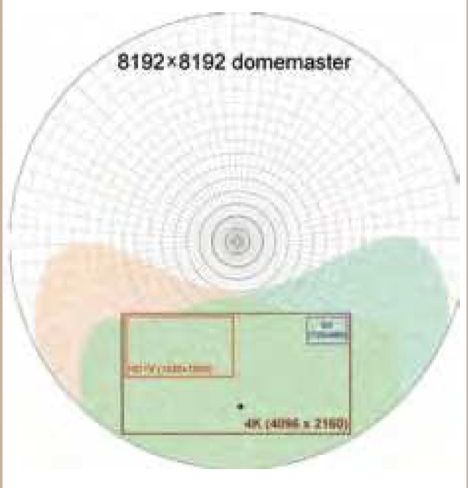
Figure 2: Comparing the resolutions of an 8K domemaster with 4K cinema projection, high-definition TV (HDTV), and standard definition (SD) video. For a dome tilted by 25°, a viewer in the center of the dome looking forward would focus on the dot 25° above the front bottom (spring line) of the dome. Overlaid is the viewer’s visual field as indicated by the green (right eye) and orange (left eye) zones, where the overlap between the two is where binocular vision occurs. The lower boundary of the visual field is 40° below the front edge of the domemaster. The diameter of the dot roughly represents the size of foveal vision, where visual acuity is the greatest.
图 2:比较 8K 球幕母版、4K 影院投影、高清电视(HDTV)、标清(SD)视频的分辨率。对于倾斜 25° 的球幕,坐在球幕中心向前看的观众会将目光聚焦在球幕前端底部弹簧线(spring line)上方 25° 的点上。图中叠加了观众的视野范围,绿色区域表示右眼视野,橙色区域表示左眼视野,两者重叠的部分是双眼视觉区。视野的下边界位于球幕母版前缘下方 40° 处。图中黑点的直径大致代表了中央凹视觉的范围,在该区域视觉清晰度最高。
In today’s digital cinemas, 4K projectors have resolutions of 4096x2160 (Jukic 2016). If we compare the resolution that is visible to an audience member in a dome theater, who cannot see the entire domemaster at once, but can only have a binocular view (with both eyes) of 180°x110° at a time (Dragoi 1997), then the visual field visible in the 8K domemaster in the forward direction has greater resolution than that of a 4K cinematic frame (Fig. 2). But even with such a wide visual field, the viewer only sees content at high visual acuity (or resolution) in the foveal part of the retina, which is only a few degrees across (represented by the black dot in Fig. 2). Our perception of the world around us is built up piecemeal by the dynamic rapid scanning and fixation with the fovea in the eyes (Yarbus 1967).
在现代数字影院中,4K 投影仪的分辨率为 4096 × 2160(Jukic 2016)。对比球幕影院中观众看到的分辨率,观众无法一次看到整个球幕母版,只能在同一时刻通过双眼看到 180° × 110° 的视野(Dragoi 1997)。在这种视野下,观众前方 8K 球幕母版的可见分辨率比 4K 电影帧要更高(图 2)。但即使有如此宽的视野,观众也只能在视网膜的中央凹部分看到视觉敏锐度(或分辨率)较高的内容,这些内容只存在于几度视角的范围中(以图 2 的黑点表示)。我们对周围世界的感知是通过眼睛中央凹的动态快速扫描和固定逐步构建的(Yarbus 1967)。
The domes of fulldome theaters range from a few meters to 30 meters in diameter. Even the smallest theaters are highly immersive, since the dome’s display surface can fill the FOV immediately visible to a viewer. The sheer physical size of the domed theater (and the similar scale of the displayed imagery) is one of the most memorable elements as noted by audience members in surveys. For instance, 22% of 161 written audience responses from the general public cited the size of the visuals as what they enjoyed most about live presentations focused on Earth (Yu 2009). Follow-up oral interviews again mentioned the screen size as an important part of the experience, with multiple respondents highlighting the ease of visibility of the images on the dome compared to a rectangularly-framed presentation in a regular auditorium.
全景球幕影院的圆顶直径从几米到 30 米不等。即便是最小的影院,也能提供强烈的沉浸式体验,因为球幕的显示表面能够迅速填满观众的整个视野。球幕影院的巨大物理规模及其展示图像的宏大尺度,是观众在调查中反馈最为难忘的特点之一。例如,在一次地球主题的球幕现场演示结束后收集了 161 名普通观众的问卷反馈,其中有 22% 的受访者表示,他们最欣赏的是视觉效果的宏伟尺度(Yu 2009)。在后续的口头访谈中,观众们再次提到银幕尺寸是该体验的重要组成部分。多名受访者强调,相比于常规影院中的矩形银幕放映,球幕影像的清晰可见性是一个突出的优势。
That such large displays are memorable is not surprising. Research comparing televisions with different screen sizes showed that the largest screens increased arousal (the physiological state of being alert, awake, and ready for action), and commanded the greatest attention (Reeves et al. 1999), while action on large screens was rated by viewers as being more intense (Lombard et al. 1997), and movement was viewed as faster, more exciting, and led to a greater sense of physical movement (Lombard et al. 2000). The combination of a physically large display and wide FOV is suspected of leading to greater learning gains in undergraduate students who viewed a live dome astronomy presentation (Yu et al. 2016).
如此大的银幕能够给人留下深刻的印象是很正常的。有研究比较了不同电视屏幕尺寸的影响,结果表明,屏幕最大的电视增加了观众的唤醒状态(即保持警觉和清醒、准备行动的生理状态),并且引起了最大的关注度(Reeves et al. 1999)。观众认为更大的屏幕所呈现的动作更加强烈(Lombard et al. 1997),运动看起来更快、更令人兴奋,并且带来了更强的身体运动感(Lombard et al. 2000)。研究认为,在观看球幕天文学现场演示的本科生中,巨大的银幕和宽广的视场角相结合,能够带来更大的学习收益(Yu et al. 2016)。
A fundamental difference between fulldome films (and its counterpart virtual reality) and traditional cinema is that the latter assumes a rectilinear (also known as linear, geometric, or classical) perspective, where the image at the picture plane represents a single viewing position and direction.
全景球幕电影(及其对应的虚拟现实电影)与传统电影的一个根本区别在于,传统电影采用直线透视(也称为线性、几何、古典)视角,这种视角假设平面上的图像代表一个单一的观察位置和方向。
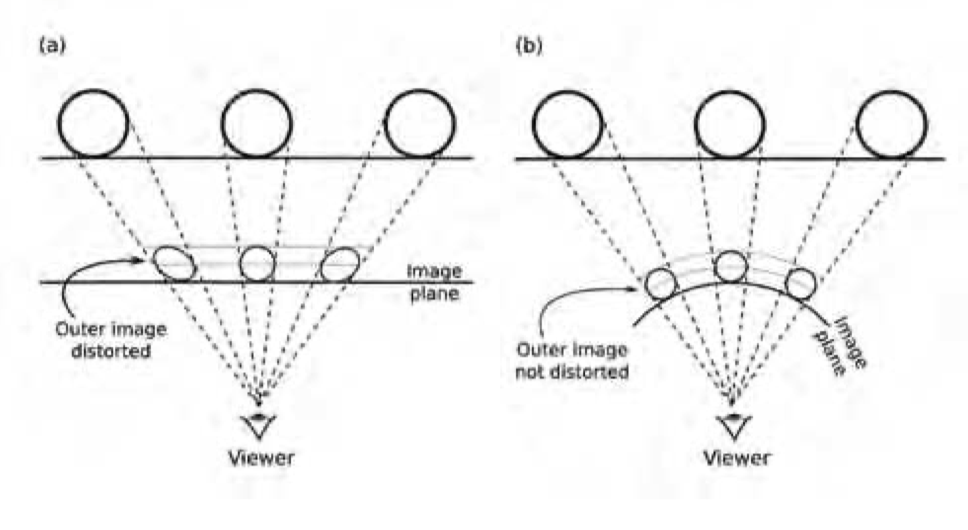
Figure 3: Examples of how projected imagery appear in (a) rectilinear and (b) curvilinear perspective.
图 3:投影的图像在 (a) 直线透视 (b) 曲线透视 下呈现的效果示例
Rectilinear perspective was perfected in the Renaissance with precise mathematical rules for determining the relationship between object size and distance. Artwork created using these rules resulted in objects that appear smaller the further they are from the eye. Objects near the center line-of-sight appear normal in rectilinear perspective. However, as an object is displaced laterally to the left or right, they look distorted because their projections are farther away (and at a greater angle) on the image plane (Fig. 3a, based on the example from Leonardo 1883, p. 63). Leonardo da Vinci was the first to suggest the alternative curvilinear (or synthetic) perspective where instead of a flat projection plane, a curved one is used. In this case (Fig. 3b), the sizes of objects are preserved correctly no matter where they appear. Curvilinear perspective therefore is an attempt to represent the undistorted view that we get when we turn our heads and eyes to examine our environment in all directions. By filming or rendering imagery in a perspective that matches the geometry of the curved screen, fulldome filmmakers are creating a visual experience that mimics the visual experience that we have as we inhabit our real-world environment.
直线透视(rectilinear perspective)在文艺复兴时期得到了发展和完善,当时的画家利用精确的数学规则来确定物体大小和距离的关系。在基于这些规则创作的艺术作品中,物体距离眼睛越远,其外观就越小。在直线透视中,位于视线中心的物体看起来是正常的。然而,当物体横向移动到左边或右边时,由于它们的投影距离图像所在平面更远(且角度也更大),因此看起来会变形(图 3a,基于 Leonardo 1883 第 63 页的例子)。列奥纳多·达·芬奇是第一个提出采用曲线透视(curvilinear perspective)或合成透视(synthetic perspective)替代直线透视的艺术家,他建议使用一个弯曲的投影平面来替代平坦的投影平面。在这种情况下(图 3b),无论物体出现在什么位置,它们的大小都能够正确地保留下来。因此,曲线透视试图模拟我们在转动头部和眼睛检查环境时所获得的不失真的视图。在拍摄或渲染球幕影像时,影像的透视与弯曲银幕的几何结构是匹配的,由此,全景球幕电影人创造了一种与我们在现实环境中的感受相仿的视觉体验。
Frames for a frameless medium 无框媒介的边框
In giant screen cinema, the projected image is so large that the edges of the frame are at the edges of one’s visual field and can effectively “disappear.” Viewers can still turn their heads to see the edges of the giant screen frame, however. The visual experience in fulldome goes even further because even the edges of the dome disappear inside a hemispherical space. Although Shedd (1989, 1999) makes a convincing argument that frames in fulldome do not exist in the same sense as in traditional cinema, we feel that a “frame” can still be defined in a way that is useful for fulldome filmmakers.
在巨幕影院中,投影的影像非常大,画面的边缘位于观众的视野边缘,几乎“消失”了。然而,观众仍然可以转头看到银幕的边缘。而在全景球幕影院中,视觉体验更进一步,因为球幕的边缘在半球空间内完全消失了。尽管 Shedd(1989,1999)提出全景球幕中不存在传统意义上的边框,我们认为仍然可以以一种对全景球幕电影人有用的方式定义“边框”。
As an example, let us use the Denver Museum of Nature & Science’s (DMNS) Gates Planetarium (Fig. 1b), which has raked unidirectional seating and a dome tilted at 25°. Seated audience members’ views of the dome surface depends on the location of their seats and how far back it is reclined. We can define the view as seen by a “reference” theatergoer seated comfortably with head resting against the seat back, gaze naturally pointed forward in a neutral position, with no pronounced head tilt to one side or up or down. This individual will find the combined binocular visual field (using both eyes) to be about 180°x110° (Dragoi 1997; also see Fig. 2).
以丹佛自然与科学博物馆(DMNS)的盖茨天文馆(图 1b)为例,该馆具有倾斜 25° 的单向座位和一个倾斜的球幕。坐在观众席上的观众观看球幕表面的视野,取决于他们座位的位置和后仰的程度。我们可以定义一个“参考”影院观众的视角,该观众舒适地坐着,头靠在座椅靠背上,视线自然向前,没有明显的头部倾斜,其使用双眼观看的视觉范围大约是 180° × 110°(Dragoi 1997;另见图 2)。
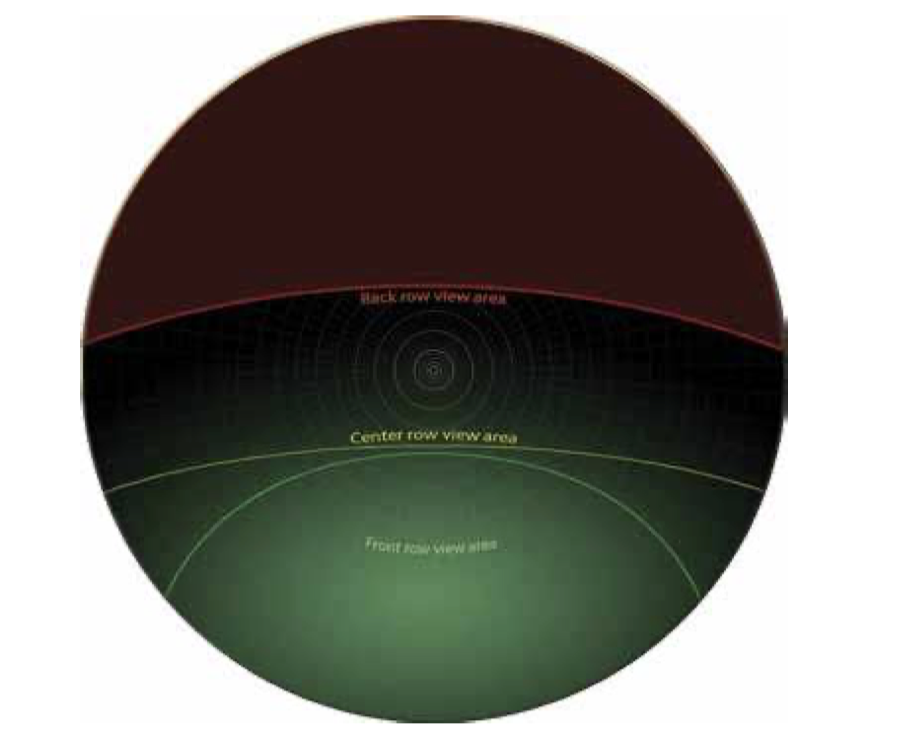
Figure 4 (top): An audience visibility map for the Gates Planetarium showing what part of the domemaster is visible for an audience in the center seat in the front row (area bound by green line), center row (area bound by yellow line), and back row (area bound by red line). The region shaded red is not visible to even someone in the back row without turning one’s head. The front part of the dome is at the bottom of the image and the back is at the top.
图 4:盖茨天文馆的观众可见性地图,展现了球幕母版对于前排中间座位(绿线区域)、中排中间座位(黄线区域)和后排中间座位(红线区域)观众可见的部分。红色阴影区域是后排观众也无法在不转头的情况下看到的区域。球幕的前一半位于图像底部,后一半位于图像顶部。
In Fig. 4, we show a fisheye view of the Gates Planetarium dome, with a grid marking out degree increments and major grid lines every 5°. The forward direction of the dome as viewed by the audience is at the bottom of the image, while the back of the dome is at the top of the image. Since the dome is tilted by 25°, the actual zenith is located 25° above the center point of the fisheye.
在图 4 中,我们展示了盖茨天文馆球幕的鱼眼视图,网格标记出每 5° 的增量和主要的网格线。观众视角的球幕前方位于图像的底部,而球幕的背面位于图像的顶部。由于球幕倾斜 25°,实际的天顶(zenith)位于鱼眼中心点上方 25° 处。
For an individual seated in the center seat of the front row, the limit of what is visible is bound by the green line and the front edge of the dome in Fig. 4. The front row seats lean back enough to allow content 45° from the zenith to be visible at the top edge of one’s vision. The viewers will have to crane their necks or twist their bodies around to view action that occurs behind the green line. Similarly, people seated in the seats closest to the center of the auditorium will have their view delimited by the yellow line. Because the seats in the center of the house do not lean back as far as the front row seats, the range of visibility is actually quite similar to that of someone from the front row. Finally, the red line shows the edge of what is visible to someone in the back row center, with the rear perimeter running close to the actual zenith of the room.
对于坐在前排中间座位的观众来说,其可见范围受图 4 中的绿线和球幕前端边缘的限制。前排座椅的后仰程度足以使从天顶向前 45° 的内容在视野顶端可见。观众必须抬起脖子或扭转身体才能看到绿线后方的画面。依此类推,坐在礼堂中间座位的观众的视野受黄线的限制。由于中间座椅的后仰程度不如前排座椅,因此其视野范围实际上与前排观众的视野相似。最后,红线显示后排中间观众的可见范围,后排边界接近影厅的实际天顶。
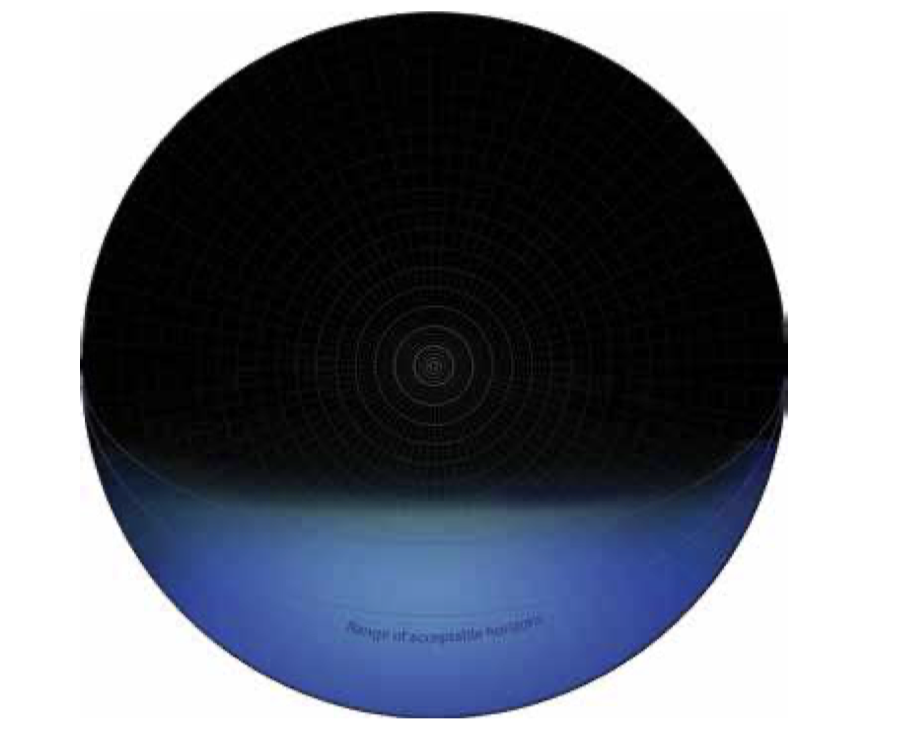
Figure 5: An audience horizon map for the Gates Planetarium showing the range of horizon tilts that look acceptable to a viewer. Shown as blue lines are two representative horizons: one for a level horizon with zero tilt, and a second where the horizon is tilted up by 25°.
图 5:盖茨天文馆的观众地平线分布图,展示了观众认为可接受的地平线倾斜范围。蓝线表示两个代表性的地平线:一个是水平地平线,倾斜度为零,另一个是上倾 25° 的地平线。
Through experiments at Gates, we discovered that a projected horizon shown in the dome could be within a range of angles away from the viewer’s personal horizon without feeling “wrong” (Yu et al. 2007; also see IMAX Corp. 1999, p. 9). Because the Gates Planetarium is tilted by 25°, the audience’s real-life horizon would cross 25° above the front edge of the domemaster. In Fig. 5, a horizon did not look unrealistic if it was offset (tilted) with respect to the real horizon anywhere inside the blue region. Thus horizons tilted lower down were acceptable, as well as ones tilted up to almost 30° above the viewer’s natural horizon. The perceptual flexibility when deciding whether a horizon looks tilted or not is fortuitous since the apparent tilt of a horizon will also depend on where an audience member is seated in the theater.
通过在盖茨天文馆的实验,我们发现球幕中投影的地平线可以放置在不同位置观众个人地平线角度的范围内,而不会显得“错误”(Yu 等,2007;另见 IMAX Corp. 1999,第 9 页)。由于盖茨天文馆有 25° 的倾斜,观众的实际地平线会穿过球幕母版的前缘上方 25° 处。在图 5 中,地平线相对于实际地平线的偏移(倾斜)只要落在蓝色区域内,就不会显得不真实。因此,较低或较高的倾斜地平线都是可以接受的,最高可达观众自然地平线上方近 30°。在判断地平线是否倾斜时,人们的感知具有灵活性,这一点很有利,因为地平线的倾斜度还会因观众在影院中的座位位置而异。
The audience visibility and horizon maps in Figs. 4 and 5 came about during the production of the film Black Holes: The Other Side of Infinity (Yu et al. 2007), when versions of them were provided to animators and visualizers as a guide for shot composition. It is specific to the dome tilt and seat lean back angles at the Gates. A map can be evaluated for every seat in the house, but for simplicity’s sake, it was decided to have the boundaries defined by the middle seats in the front, center, and back rows. The lines that circumscribe the audience members’ views of the dome in these rows help determine where the visual “safe area” is located. Visual content must be placed forward of the green line in Fig. 4 in order to be visible to anyone seated in any center seat from the front to the back row without moving their heads. If a visual element is placed outside of the front row safe area, the viewer must be cued to turn and look in a direction that she was not looking before. We will describe ways that this can be done in Part II.
图 4 和图 5 中的观众可见性和地平线分布图都是在制作电影《黑洞:无限的另一面》(Black Holes: The Other Side of Infinity,2006)时绘制的(Yu 等,2007),当时这些示意图供动画师和可视化制作者使用,作为镜头构图的指南。这些示意图是对应于盖茨天文馆特定的球幕倾斜和座椅后仰角度的。虽然可以为影院中的每个座位绘制一张评估图,但为简化起见,决定以前排、中排和后排中间座位定义不同区域的边界。在这些位置观看球幕的观众视野所圈定的线条,有助于确定视觉“安全区”的位置。视觉内容必须放置在图 4 中的绿线前方,以便从前排到后排任何中间座位的观众无需移动头部即可看到。如果视觉元素放置在前排安全区之外,就需要主动提示观众转头查看之前没有观看的方向。我们将在第二部分描述如何实现这一点。
Because Fig. 4 was developed specifically for DMNS’ Gates Planetarium, a corresponding diagram for another dome theater with unidirectional seating will differ in the details, but we would expect it to look similar. For a dome with concentric or epicentric seating, it may not be possible to define a safe area that is equally visible everywhere in the theater outside of the zone around the zenith. For imagery located near the edge of the domemaster, the virtual camera will have to “pan” the visual content so that it “circulates” around the dome in order to be noticed by all audience members. Ideally an individualized visibility grid should be tailored for each theater. But pragmatically, a film producer will likely use just one map to guide content placement for all unidirectional tilted theaters, and a second one for concentric and epicentric theaters.
由于图 4 是专为 DMNS 的盖茨天文馆设计的,因此对于另一个具有单向座位的球幕影院而言,其示意图的细节会有所不同,但整体上应该是相似的。对于具有同心(concentric)或偏心(epicentric)座位的球幕影院,可能无法定义一个在影院所有座位区域均可见的安全区。对于位于球幕母版边缘的影像,虚拟摄影机将不得不“平移”视觉内容,以便让所有观众都能注意到。理想情况下,应为每个影院定制一套个性化的可见性网格。但实际上,电影制作人可能只用一张共同的示意图来指导所有单向倾斜影院的内容放置,而用另一张示意图指导同心和偏心球幕影院的内容放置。
Slowing action for giant screens 放慢巨幕电影的动作
When filmmakers started working in giant screen cinema, they had to modify the traditional filmmaking techniques they had learned previously. First, they argued that large format films need to be slower paced than traditional cinema. That is, the individual shots need to be longer so that a film would have fewer cuts and total number of shots. IMAX® and OMNIMAX® directors recognized that the frame was so large that viewers needed time to scan the image and take it all in (Tilton 1973; MacGillivray & Freeman 1976). Directors found that IMAX® films could stimulate a viewer’s wonder with views of awe-inspiring natural phenomena, the use of wide vistas, and soaring aerial shots (Crosby 2007).
当电影人开始制作巨幕电影时,他们需要调整之前学到的传统电影制作技巧。首先,他们认为巨幕格式电影的节奏需要比传统电影更慢。也就是说,单个镜头的时间需要更长,从而使电影的剪辑次数和镜头总数减少。IMAX® 和 OMNIMAX® 的导演认识到,银幕如此之大,观众需要时间来浏览整个画面并理解其内容(Tilton 1973;MacGillivray & Freeman 1976)。导演们发现,在 IMAX® 电影中展示壮丽的自然景象、广阔的视野和高空航拍镜头,能够激发观众的惊奇感(Crosby 2007)。
When the audience is immersed inside a “frameless” flight over a landscape, the camera motion translates into the entire on-screen environment moving. The audience’s view is filled almost entirely with these cues suggesting that they that are moving. Instead of a secondhand experience of viewing the subject of a film from afar, the audience perceives that they are experiencing what is happening on-screen to them in first person (Shedd 1989). When the audience is taken on an aerial flight, the filmed horizon dominates the visual field so any pitching or banking by the camera results in the audience feeling that they and the entire theater are experiencing that motion (Shedd 1999).
当观众沉浸在无边框的飞越景观中时,摄影机的运动就会变成整个银幕环境的运动。观众的视野几乎全部被移动的线索占据,这些线索提示着观众场景正在运动。观众不再是远距离观看电影内容,而是感觉自己正在亲身体验银幕上的事件(Shedd 1989)。当观众被影片带着在空中飞行时,影片拍摄的地平线占据了视野范围,因此摄影机的任何俯仰或倾斜都会让观众感觉他们和整个影院都在经历这种运动(Shedd 1999)。
The sweeping camera movements can lead to this appearance of movement because of vection, the sensation of self-motion even when the observer is stationary. Experiments show that if viewers see apparent motion in their peripheral vision, the resulting vection produces an illusion of self-motion. Conversely, if motion appears only in the center of the visual field, the subjects feel that only the object in the scene is moving while they remain stationary (Brandt et al. 1973). The generation of vection explains why giant screen cinema and fulldome films can be more involving for the audience.
这种摄影机的扫视运动会导致一种“自运动”(vection)的感觉,即使观察者静止不动,也会产生这种感觉。实验表明,如果观众在周边视觉(peripheral vision)中看到明显的运动,则由此而来的“自运动”会带来自身在移动(self-motion)的错觉。相反,如果运动仅出现在中心视觉内,那么观众会感觉场景中的物体在移动,但观众自己保持静止(Brandt 等,1973)。“自运动”现象解释了为什么巨幕影院和全景球幕电影能让观众更有参与感。
Unfortunately, this involvement can also cause viewers to develop simulator motion sickness due to the disparity between the audience’s inner ear vestibular systems which suggest they are motionless, and the visuals which give the illusion that the audience is moving. Increasing the rate of motion and widening the FOV so that more of the visual periphery is stimulated are two factors that can worsen motion sickness (LaViola 2000).
然而,这种参与感也可能导致观众产生模拟器晕动症(simulator motion sickness),因为观众的内耳前庭系统提示当前自身是静止不动的,而视觉所见却给观众一种自己在移动的错觉。可能加剧晕动症的因素有两种,一是是运动速度的增加,二是视野的扩大,它们都会刺激到更多的周边视觉(LaViola 2000)。
Another reason for slowing the action has to do with a visual artifact when objects move too fast on film. An object in motion will appear at different positions in its trajectory in multiple consecutive frames. When projected at normal speed, persistence of vision fuses the individual appearances into the apparent continuous motion of the object. When the screen is too large, however, a moving object will strobe as a series of offset images (Shedd 1998). For giant screen filmmaking, Shedd (1989) recommends that camera pans should move no faster than about 1 degree of arc per second of time in order to minimize this problem. Alternatively, motion blur can be used to smooth over the effect.
需要将动作放慢的另一个原因是,物体在电影中移动过快时会产生视觉伪影(visual artifact)。一个运动中的物体在多个连续帧中会出现在不同的位置上。当以正常速度放映时,视觉暂留(persistence of vision)将这些单独的图像融合成连续运动。然而,当银幕过大时,运动物体会闪烁成一系列错位的图像(Shedd 1998)。对于巨幕电影制作,Shedd(1989)建议摄影机的平移速度不超过约 1 度弧度每秒(1 degree of arc per second),以尽量减少这个问题。此外也可以使用运动模糊来平滑效果。
Cuts and other transitions that lead to new scenes can be disorienting in immersive cinema as well. Shedd (1989) describes the phenomenon of “instant subtraction,” where an object the audience has been looking at suddenly disappears with the onset of a cut. The pacing of the film (how quickly the edits occur) has to be reduced to minimize such subtractions to the audience experience. A film that is cut with a rhythm that looks normal on a normal movie theater screen will appear too fast-paced for the dome. Early OMNIMAX® filmmakers doubled or tripled the length of shots to give viewers time to scan the larger image and adjust to the new scene (Tilton 1973; Wollen 1993).
在沉浸式影院中,当采用剪辑或其他转场手段来转向新场景时,也会让观众迷失方向。Shedd(1989)描述了“瞬间消失”(instant subtraction)现象,即观众一直在看的物体在镜头剪辑的瞬间突然消失。电影的节奏(剪辑速度)必须减缓,以尽量减少这种情况对观众体验的干扰。在普通影院银幕上看起来节奏正常的电影,在球幕上会显得节奏过快。早期的 OMNIMAX® 电影制片人将镜头长度增加了两到三倍,以便观众有足够的时间浏览尺寸更大的影像并适应新场景(Tilton 1973;Wollen 1993)。
The above guidelines have been adopted by many fulldome filmmakers. But since fulldome theaters have such wide FOVs, some directors have slowed the camera motion and pacing in their productions even more to avoid motion sickness. The number of shots and cuts in many fulldome films were reduced to a bare minimum. For instance, the first production from the American Museum of Natural History (Passport to the Universe, 2001) consisted of just four individual shots. Camera motion did not disappear despite this. Similar to the soaring aerial shots of IMAX®, virtual flights through space were compelling experiences, and could be used to impart information, such as the graceful spiraling camera motions in Passport to the Universe that conveyed the dimensionality of astrophysical phenomena (Sweitzer 2001).
这些指导原则已被许多全景球幕电影人采用。但由于全景球幕影院的视野非常宽广,一些导演在制作中进一步放慢了摄影机运动和节奏,以避免晕动症。许多全景球幕电影的镜头数量和剪辑次数减少到了最低限度。例如,美国自然历史博物馆的第一部作品《通往宇宙的护照》(Passport to the Universe,2001)仅由四个单独的镜头组成。尽管如此,摄影机运动并未完全消失。与 IMAX® 的高空航拍镜头类似,穿越太空的球幕虚拟飞行是一种引人入胜的体验,并且可以用于传授知识,例如《通往宇宙的护照》中优雅的摄影机螺旋运动就传达了天体物理现象的立体感(Sweitzer 2001)。
Following Shedd’s description of the audience experiencing instead of watching the events on-screen, one can argue that a fulldome cinematic tour is akin to experiencing a journey, rather than merely watching it. For the best audience experience, it follows then that the visual journey should be visually continuous, and the storytelling should be carefully tailored to the virtual trek. There should be a tight integration of narration and visuals, especially since many fulldome shows are about astronomical locales that are unfamiliar to the public. This cumulative experience has been called the “narrative journey” (Wyatt 2005), where the visual tour is augmented by a narration track to create “an intellectual and affective excursion reinforcing the itinerary.”
根据 Shedd 的描述,观众是在主动体验银幕上的事件,而非被动观看事件。由此可以认为,全景球幕电影之旅类似于体验一场旅程,而不仅仅是观看旅程。为了使观众体验达到最佳,这场旅程应该是视觉上连续的,应该精心安排叙事使其与虚拟旅程相匹配。因为许多全景球幕影片关注的是公众不熟悉的天文学场景,所以应该将旁白与视觉紧密结合起来。这种不断累积的体验被称为“叙事旅程”(Wyatt 2005),在这样的旅程中,视觉之旅通过旁白音轨得到增强,以创造“一段强化行程的智力与情感之旅”。
Pacing of theatrical features, IMAX® 影院长片与 IMAX® 影片的节奏
Despite the convention of reducing the pacing of large screen films, there have been many recent counter-examples to this paradigm. Since 2002, Hollywood movies produced originally in traditional 35-mm film (or its digital equivalent) have undergone Digital Media Remastering (DMR) for exhibition in IMAX® screens (Heuring 2008). Hollywood productions are now even shot natively in digital IMAX® cameras (with the frame cropped for projection in conventional theaters; Lang 2016). How can such fasterpaced feature films be shown and be successful on giant screens, given what we have noted above? Do fast-paced IMAX® films mean that fast-paced fulldome films are also possible?
尽管大银幕电影的节奏放慢已成为惯例,但最近有许多例子反驳了这一经验范式。自 2002 年以来,一批最初使用传统 35 毫米胶片(或其数字等效物)拍摄的好莱坞电影经过数字媒体重制(DMR)在 IMAX® 银幕上放映(Heuring 2008)。如今的好莱坞电影甚至直接使用 IMAX® 支持的数字摄影机拍摄,并裁切画面以便在传统影院放映(Lang 2016)。基于上述情况,这些快节奏的长片电影如何能够在巨幕上放映并取得成功?快节奏的 IMAX® 电影是否意味着快节奏的全景球幕电影也是可行的?
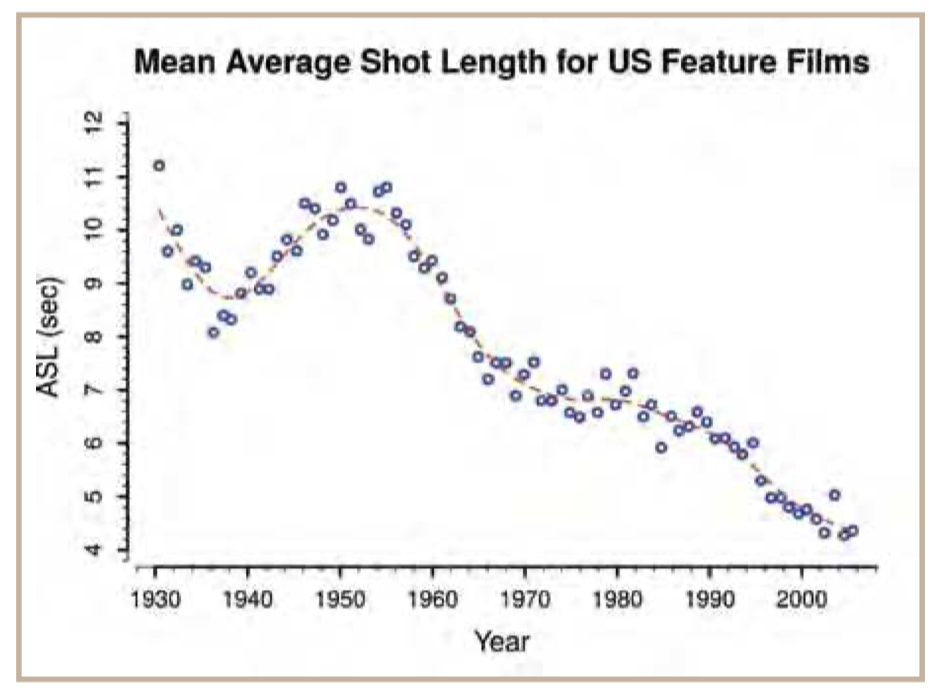
Figure 6: Average shot lengths of U.S. feature films from 1930-2005 with data from Salt (2009).
图 6:美国 1930-2005 年长片的平均镜头长度(Salt,2009)
To examine this question, we first investigated the pacing of traditional Hollywood feature films, which can be quantified by the average shot length (ASL) of a film, determined by taking the total length of the film and dividing by the number of cuts or edits. Analyses show that Hollywood silent features in the 1920s were cut quite fast, with many having ASLs in the 4-6 sec range (Bordwell 2006, p. 121). With the advent of sound, pacing and camera motion slowed down as equipment proliferated and became bulkier (Bordwell 2006, p. 145). Fig. 6 shows the average ASLs as calculated by Salt (2009) for films from 1930 to 2005.
为了研究这个问题,我们首先调查了传统好莱坞长片的节奏,可以通过电影的平均镜头长度(ASL)来量化,这一数值由电影的总时长除以剪辑次数得出。分析显示,20 世纪 20 年代的好莱坞无声电影剪辑速度相当快,许多电影的 ASL 在 4 到 6 秒之间(Bordwell 2006,第 121 页)。随着有声电影的出现,由于设备变得更多且更笨重,影片节奏和摄影机运动均有所放缓(Bordwell 2006,第 145 页)。图 6 显示了 Salt(2009)计算的 1930 年至 2005 年电影的平均 ASL。
Starting with a high of more than 11 sec in 1930, the average ASLs decreased by almost a factor of three by the 21st century. There is a bump up in shot lengths during the period 1947-1955 due to the advent of CinemaScope and other widescreen film formats. Directors, producers, and editors slowed down the pace of these films with longer takes. But once it was realized that audiences could handle faster cutting, the ASLs started falling again.
从 1930 年超过 11 秒的最高值算起,好莱坞电影的平均 ASL 在 21 世纪前减少了近三倍。1947 年至 1955 年期间,由于 CinemaScope 和其他宽银幕电影格式的出现,镜头长度有所增加。导演、制片人和剪辑师通过更长的镜头来放慢这些电影的节奏。但在人们意识到观众可以应对更快的剪辑后,ASL 又开始下降。
Although the drop in ASLs has been criticized as part of a trend of incoherence in recent blockbuster films (e.g., see the discussion of “chaos cinema” by Stork 2011a, 2011b), analyses of cinematic trends show that film storytelling has not fundamentally changed (Bordwell 2006). Filmic techniques that originally evolved in the 1910s and 1920s are still being used, but in different proportions than that found in the “classical” Hollywood studio period that lasted until the 1960s.
尽管有批评指出 ASL 的下降是近期票房大片电影混乱趋势的一部分(如 Stork 2011a,2011b 关于“混乱电影”的讨论),但对电影发展趋势的分析表明,电影叙事并没有发生根本性的变化(Bordwell 2006)。1910~1920 年代最初发明的电影技巧仍在使用,但其使用比例与 1960 年代以前的“经典”好莱坞制片厂时期影片已经有所不同。
The new style that has evolved in recent decades is called “intensified continuity” by David Bordwell, who cites not only rapid editing, but also the mixed use of wideand narrow-angle lenses, close framings in dialogue scenes, and moving cameras as hallmarks of this modern aesthetic. What is important to note about intensified continuity is that this style is not restricted to just action films. Bordwell points out that starting in the mid-1960s, films of all genres—including dramas, comedies, romances, and musicals—started adopting faster-paced editing, and even directors known for slower paced features in the past started making films with contemporary pacing (Bordwell 2006, pp. 121-124).
在过去的几十年里,电影制作的新风格被 David Bordwell 称为“强化的连续性”(intensified continuity)。他指出,这种现代美学的标志不仅仅是快速剪辑,还包括广角和窄角镜头的混合使用,对话场景中的紧密构图,以及摄影机的运动。重要的是,强化的连续性并非仅限于动作片。Bordwell 指出,从 20 世纪 60 年代中期开始,各种类型的电影——包括剧情片、喜剧片、爱情片和音乐剧——都开始采用更快的剪辑节奏,甚至那些过去以慢节奏影片著称的导演也开始制作节奏更快的电影(Bordwell 2006,第 121-124 页)。
The historical pacing of IMAX® films has not been rigorously studied. But in Table 1, we list the ASLs for a number of IMAX® films that we could find in the literature as well as from our own timings (where no footnote is given for a citation). The list includes one of the earliest IMAX® films (North of Superior) as well as the OMNIMAX® film The Dream Is Alive. When compared with Fig. 6, the slowest paced IMAX® films have ASLs that are twice the length of the slowest U.S. feature films from the 1930s and 1950s. However, many giant screen films over the years have ASLs approaching the maximum mean U.S. feature film ASL values of 10-11 sec, including North of Superior and Tropical Rainforest (directed by Ben Shedd). By the late 1990s and the early 2000s, some large screen films have ASLs that drop below 10 sec, approaching average Hollywood feature film ASLs from the 1970s.
IMAX® 电影节奏的历史发展尚未得到系统研究。但在表 1 中,我们列出了一些 IMAX® 电影的 ASL,包括在文献中找到的数据和我们自己统计的数据(未注明出处的为我们自己的数据)。这个列表包括了最早的 IMAX® 电影之一《苏必利尔之北》(North of Superior,1971)以及 OMNIMAX® 电影《执着的梦想》(The Dream Is Alive,1985)。与图 6 相比,节奏最慢的 IMAX® 电影的 ASL 是 1930 年代和 1950 年代节奏最慢的美国长片电影 ASL 的两倍。然而,多年来许多巨幕电影的 ASL 接近美国长片电影的最大 ASL(10-11 秒),包括《苏必利尔之北》和《热带雨林》(Tropical Rainforest,1992,Ben Shedd 导演)。到 20 世纪 90 年代末和 2000 年代初,一些大银幕电影的 ASL 降至 10 秒以下,接近 1970 年代好莱坞长片电影的平均 ASL。
The popularity of films like Pulse: A Stomp Odyssey (6.1 sec ASL) shows that faster-paced giant screen films are possible. Instead of just a few locations, this film ventures out to cover dancers and musicians in locales on five continents. Each set piece contains from one to hundreds of performers. The scenes are edited together from shots from multiple camera set-ups, including close-ups (showing performers shoulders and up), medium (waist and up), and long shots (showing entire bodies); dolly shots where the camera is moving on tracks or on a Steadicam, and crane shots with the camera rising up or down in the air.
的《破铜烂铁2:脉动冲击》(Pulse: A Stomp Odyssey,2002,ASL 为 6.1 秒)等电影的流行表明,快节奏的巨幕电影是可能的。这部电影的取景地点很多,展现了横跨五大洲的舞蹈家和音乐家的表演场景。每个场景中都有一名到数百名表演者,由多机位镜头剪辑而成,包括特写(肩膀以上)、中景(腰部以上)和远景(整个身体),以及推轨镜头(摄影机在轨道或斯坦尼康上移动)和起降镜头(摄影机在空中上升或下降)。
When there are multiple performers, they are lined up across the horizon or massed throughout the screen, meaning there is not just one location the director wants the audience to look at; the viewer has the freedom to shift attention to multiple points on-screen.
当场景中有多个表演者时,他们沿着地平线排列或分布在整个银幕上,这意味着导演不希望观众只看一个地方,观众可以自由地将注意力转移到银幕上的多个点位。
The film remains watchable (with a 93% critics score on RottenTomatoes) even when the pacing drops to a quick 4.1 sec ASL (in the sequence with the timbalada drummers in Salvador, Brazil) because the main focus of most shots is the human body, with faces that easily draw attention (for more on this, see Part II). The performers are often in the frame center (or close to it) also making it easy to stay focused on the action after each cut.
即便在节奏加快到 ASL 仅有 4.1 秒的情况下(在巴西萨尔瓦多的 Timbalada 鼓手段落中),这部电影仍然有可看性(在 RottenTomatoes 上获得了 93%的影评人评分),因为大多数镜头的主要焦点是人的身体,聚焦在容易引起注意的面部特征上(更多内容见第二部分)。表演者通常在画面中心或接近中心,这也使得在每次镜头剪辑后观众能够保持对动作的关注。
Nucci (2005) notes that films like Pulse: A Stomp Odyssey goes against the conventional wisdom about how fast editing for giant screen films could be, but also other edicts such as that performers must not appear in a close-up lest their heads end up too high on-screen (Tilton 1973). Nucci believes that since IMAX® films have been dominated by educational films, this genre has set the norm for what is permissible in giant screen filmmaking. Thus nature documentaries are often filled with landscapes which demand stationary shots for viewers to take in vistas, while grand, swooping aerial views of the same also require long shots. This type of slow-paced filmmaking became the prevailing style of giant screen cinema, even though there are not any technical limitations to prevent filmmakers from doing otherwise (Nucci 2005).
Nucci(2005)指出,《破铜烂铁2:脉动冲击》这样的电影打破了关于巨幕电影快速剪辑的传统观念,也打破了其他规范,比如表演者不能出现在巨幕的特写镜头中,以免其头部在银幕上显得太高(Tilton 1973)。Nucci 认为,由于 IMAX® 电影主要以科教类电影为主,因此这一类型设定了巨幕电影制作的成规。在这些自然纪录片中常常充满了由固定镜头呈现的让观众一览无余的景观,而宏大的、扫视的航拍镜头也需要持续更长的时间。这种慢节奏的电影制作风格成了巨幕电影的主流,虽然技术手段其实并未限制电影人采用其他手法(Nucci 2005)。
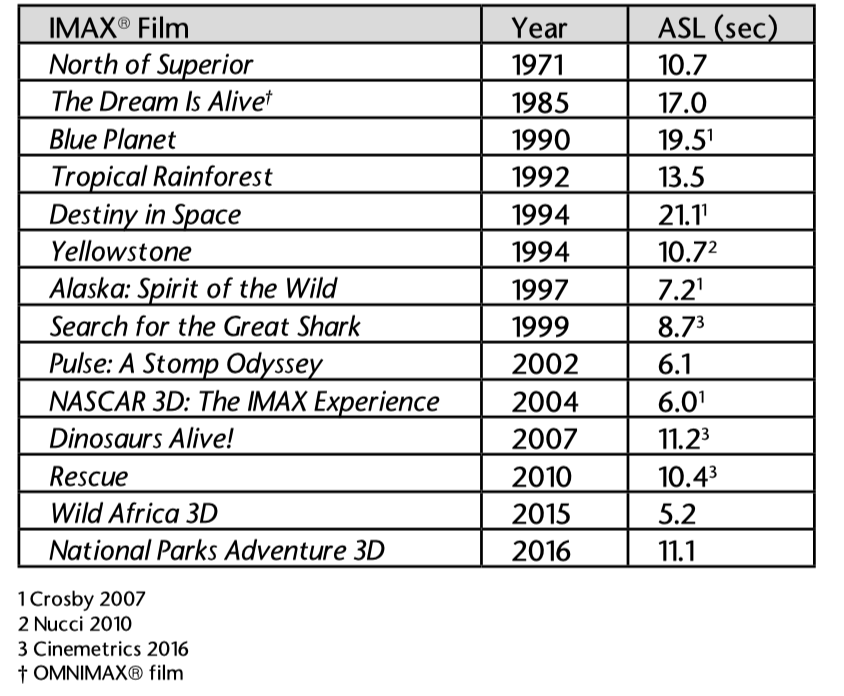
Table 1: Average shot lengths of IMAX® films.
表 1:IMAX® 电影的平均镜头长度
Films such as Pulse and NASCAR 3D demonstrated that faster-paced giant screen films could not only be made, but also be popular with audiences as well.1 Although the films in Table 1 have ASLs no faster than the average Hollywood features from the 1970s to the 1980s, they portend the appearance of even faster Hollywood movies that would appear on IMAX® screens courtesy of DMR.
像《破铜烂铁2:脉动冲击》和《超级三维赛车》(NASCAR 3D,2004)这样的电影证明,快节奏的巨幕电影不仅在制作上是可行的,而且也能受到观众欢迎。尽管表 1 中电影的 ASL 没有比 1970~1980 年代好莱坞长片电影的平均 ASL 更快,但它们预示着通过 DMR 转制之后,在 IMAX® 银幕上会出现节奏更快的好莱坞电影。
The Pacing of fulldome films 全景球幕电影的节奏
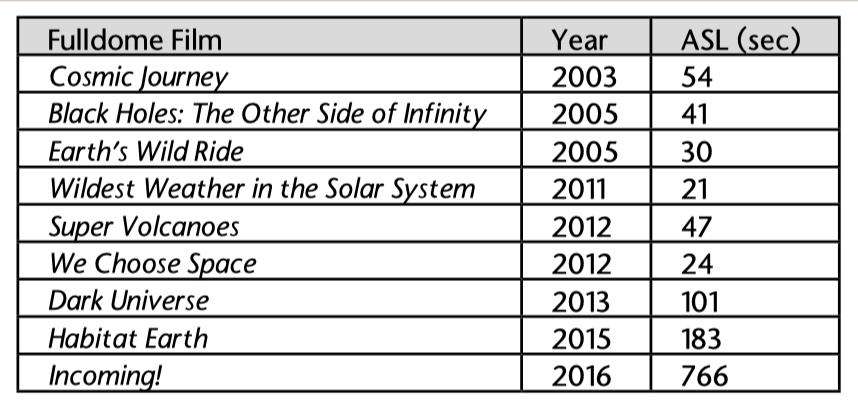
Table 2: Average shot lengths of a sample of fulldome films.
表 2:一组全景球幕电影样本的平均镜头长度
The Dream Is Alive is the only OMNIMAX® film in Table 1, and is a harbinger of how fast fulldome films could possibly be cut. In fact, the limited listing of fulldome ASLs in Table 2 suggest that many (and perhaps most) fulldome films are much slower paced than even OMNIMAX® films. Even the fastest-paced film in our small sample, Wildest Weather in the Solar System with 21 sec ASL, is only as fast as the giant screen films from the early 1990s, and have shot lengths about twice that of the average Hollywood feature from the 1930s to 1950s. As the preceding analysis shows, there is no technical or perceptual reason why fulldome films need to be as slow as they are. They could but are not cut even as fast as an OMNIMAX® film.
《执着的梦想》是表 1 中唯一的 OMNIMAX® 电影,预示了全景球幕电影可能的剪辑速度。事实上,表 2 中的全景球幕电影 ASL 数据显示,许多(甚至可能是大多数)全景球幕电影的节奏比 OMNIMAX® 电影还要慢。即使是我们所选择的例子中节奏最快的《太阳系中最狂野的天气》(Wildest Weather in the Solar System,2011),其 ASL 为 21 秒,也仅与 20 世纪 90 年代初的巨幕电影相仿,其镜头长度约为 20 世纪 30~50 年代好莱坞长片电影的两倍。前面的分析显示,没有技术上的或感知上的理由表明全景球幕电影需要如此慢的节奏。它们完全可以像 OMNIMAX® 电影那样采用快节奏剪辑,但实际上并没有这样做。
In the end, constructing a film with so few shots is a conscious stylistic or educational choice by a filmmaker. The final two films in Table 2 are from the California Academy of Sciences and are directed by one of the authors (Wyatt). They exemplify the narrative journey approach to storytelling, using continuous camera motions with a minimal number of edits. Habitat Earth consists of eight scenes, while Incoming! has just two long shots.
总结起来,使用数量如此之少的镜头构建电影,是电影人的一种有意识的风格选择或教育选择。表 2 中的最后两部电影来自加州科学院,由本文作者之一 Wyatt 执导。它们体现了“叙事旅程”的手法,通过连续的摄影机运动和最少的剪辑次数来讲述故事。《地球:万物的栖息地》(Habitat Earth,2015)由八个场景组成,而《来袭!》(Incoming!,2016)只有两个长镜头。
Many space science fulldome films employ a smooth flight via a single camera maneuvering through planetary and astronomical datasets. This was the style of the early fulldome film Passport to the Universe (2001), which introduced the now standard navigational arc of starting on or near Earth before launching the viewer into deep space. This format was repurposed and reversed for the nonastronomical show Life: A Cosmic Story (2010; Wyatt et al. 2012), which starts in a redwood forest but then zooms into smaller scales until the audience is viewing the animated motions of molecules engaged in photosynthesis inside a plant cell.
许多太空科学主题的全景球幕电影采用单一摄影机平稳飞越行星和天文数据集的方式。早期全景球幕电影《通往宇宙的护照》就采用了这样的风格,该片引入了现在已成标准的“导航叙事弧”(navigational arc),从地球或近地位置开始,逐步将观众带入深空。这种制作方式后来被重用于非天文题材影片《生命:一个宇宙的故事》(Life: A Cosmic Story,2010)(Wyatt 等,2012),该片从红杉森林开始,随后向着更小的尺度缩放,直到观众看到在植物细胞内进行光合作用的分子动画。
But this is also a navigational paradigm intrinsic to planetarium visualization software, where the default real-time flight is a camera zoom similar to what is seen in Ray and Charles Eames’ Powers of Ten film (Emmart 2005). Although the research is limited, the Powers of Ten approach has been shown to be effective for helping students understand scale. The original short film has been shown to be of educational value (Jones et al. 2007), while recreations of the zoom out viewed in a fulldome planetarium result in greater retention and understanding about scale in college students compared to flat screen versions of the same visuals (Yu, Sahami, & Dove 2016).
这同样体现了天文馆可视化软件中一种固有的导航理念,其默认的实时飞行模式是采用相机变焦效果呈现的,类似于 Ray Eames 和 Charles Eames 在电影《十的次方》(Powers of Ten,1977)中采用的手法(Emmart 2005)。尽管相关研究并不广泛,但《十的次方》采用的手法已被证实对于帮助学生理解尺度概念非常有效。原始短片本身已被认为具有教育意义(Jones 等,2007),而在全景球幕天文馆中重现的变焦放大(zoom out)效果,相较于同一视觉效果的平面银幕版本,能够显著提高大学生对尺度概念的理解和记忆(Yu,Sahami,& Dove 2016)。
With fewer cuts and slower pacing, a continuous shot that connects different size domains allows audiences to see the relationships and nested contexts between natural phenomena. This is especially important in astronomy, where the content is beyond the ordinary everyday experience of the general public. Having this additional context can be important for promoting understanding.
通过减少剪辑并放慢节奏,一个流畅的长镜头贯穿不同尺度的空间,让观众得以洞察自然现象间的相互联系及其背后的层次结构。这在天文学中特别重要,因为这些内容超出了公众的日常经验范围。提供这些额外的层次结构信息对于促进理解非常重要。
Even for live fulldome lectures focused on Earth topics, audience members cited zooming and seeing details at multiple geographic scales as something they liked best about the presentation in the planetarium (Yu 2009). Such transitions place local phenomena within a global context, which is important when teaching about interconnected Earth systems where global environmental change phenomena can manifest itself in different ways at different scales (Yu et al. 2013). Finally, such unbroken transitions may help make a visceral connection to the viewer. As one of us has written (Wyatt 2014),
即便是在专注于地球主题的全景球幕现场讲座中,观众也普遍表示,他们最欣赏的是能够在天文馆中通过变焦缩放效果,在不同的地理尺度上观察到细节(Yu 2009)。这种视觉转换将局部现象置于全局背景中,这对于讲授地球各系统相关性的知识尤其重要,因为全球环境变化的现象在不同尺度上会以不同方式表现出来(Yu 等,2013)。最终,这种连续的视觉过渡可能有助于与观众建立一种深刻的情感联系。正如本文作者之一所述(Wyatt 2014):
… transitions in scale are particularly amenable to the immersive environment, allowing viewers to experience continuous changes in size relationships that helps in constructing mental models of the phenomena. Thus, when we depict human-scaled phenomena in a fulldome planetarium—and then continuously transition to larger or smaller scales—we have an opportunity to connect spatial relationships that include our own human, embodied experience …
[A shot that transitions through multiple scales] enables viewers to link the objects and the concepts in a coherent, unified fashion. It establishes context for the viewer in a highly visual, intuitive, and visceral manner.
… 尺度转换特别适合于沉浸式环境,它使观众能够体验连续的大小变化,有助于构建观众对自然现象的心理模型。因此,当我们在全景球幕天文馆中展示人类尺度的自然现象,然后不断过渡到更大或更小的尺度时,我们有机会将这些空间关系与我们自身的人类经验联系起来…
“一个在多个尺度间转换的镜头”使观众能够连贯、统一地理解物体和概念。这以高度视觉化、直观和生动的方式,为观众建立了将现象联系起来的背景。
A Theory of Immersive Cinema 沉浸式电影理论
Traditional film has built up a repertoire of cinematic language that describes the fundamental elements of shots or scenes, and this language can be used by giant screen and fulldome filmmakers. However, as Ben Shedd has pointed out (1989) and as described in §4, another paradigm exists where the film frame disappears and what is shown can be thought of as an environment that the audience feels is personally experiencing. Here, we describe a theoretical framework where we assume as given the fundamental axiom, Action is happening to the audience, instead of being viewed on-screen by the audience. We can then ask, how do we re-frame cinematic language for fulldome so that the vocabulary is centered around the audience experience?
传统电影已经发展出一套描述镜头和场景基本元素的电影语言,这套语言可以被巨幕和全景球幕电影人所使用。然而,正如 Ben Shedd(1989)以及第 4 节所述的那样,还存在另一种范式,在这种范式中电影的边框消失,影片所呈现的内容被观众视为他们亲身体验的环境。在这里我们描述一个理论框架,其中假设一个基本公理:对观众而言,动作是发生在自己身上的,而不是在银幕上观看的。由此我们可以提问,如何重新定义全景球幕电影的电影语言,使其相关术语能够围绕观众体验展开?
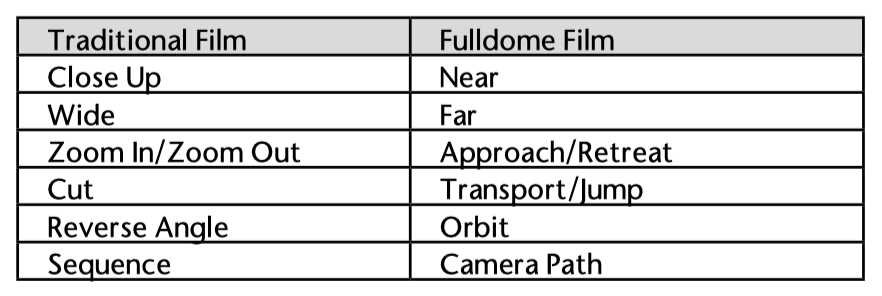
Table 3: A list of types of camera shots and movements in traditional cinema with their complements in our theory of immersive cinema.
表 3:传统电影中的摄影机镜头和运动术语,及其在全景球幕电影中的对应术语
We propose a short list of terms from traditional cinema in Table 3 with their corresponding re-framings in immersive cinema. The list above is not meant to be complete, but is intended to start a dialogue for others interested in exploring this model and re-thinking these basic filmmaking concepts. We stress that this theoretical approach to immersive cinema is neither the only filmmaking style that can be applied to fulldome film, nor even what is recommended in some situations. Our earlier discussion of Pulse: A Stomp Odyssey shows that there are no absolute rules that apply equally in all situations for giant screen film. But by organizing the results from this assumption of audience immersion, we propose a common vocabulary to promote further discussion and exploration. Filmmakers can help confirm or invalidate elements of this theory with examples from their films, and researchers can do the same with audience studies.
我们在表 3 中列出了一些传统电影术语,及其在沉浸式影院中重新定义的对应术语。对于有兴趣探索这一模型并重新思考这些基本电影概念的人们而言,这份列表虽不完整,但可以作为开启对话的契机。我们强调,这种沉浸式影院的理论方法既不是唯一适用于全景球幕电影的手法,甚至在某些情况下并不推荐采用。我们早前讨论的《破铜烂铁2:脉动冲击》表明,没有一套绝对规则适用于所有巨幕电影的情况。但通过整理一系列基于观众沉浸感的假设,我们提出了这套通用的术语表,旨在引发进一步的讨论和探索。电影人可以用自己制作的影片作为例子,来验证或推翻这一理论中的元素,研究人员也可以通过对观众的研究来进行验证。
Based on our fundamental axiom of immersive cinema, the audience occupies the same environment as the characters in the film, and distinctions erode between shots that are objective (distant and independent) and subjective (personal point of view). The audience member becomes a participant, and it follows then that immersive filmmaking is inherently a subjective experience. Hence, while static camera setups in traditional cinema that use lenses to control the visual field of what is visible on a framed screen, terms such as “close up” and “wide” shots describe how much the object of interestoften a person—fills the screen.
基于上述关于沉浸式影院的基本公理,观众与电影中的角色处于同一环境中,客观镜头(独立的远景镜头)和主观镜头(个人视角镜头)之间的区别逐渐消失。因为观众成了参与者,所以沉浸式电影制作本质上是一种主观体验。因此,在传统电影中,静态摄像机通过镜头调整来控制观众在画框式屏幕上看到的视野范围,而诸如“特写”和“广角”等术语则描述了被摄对象(通常是人物)在银幕上所占据的空间大小。
For instance, a close up, when in reference to an actor, describes a shot in which the actor is visible in frame from the shoulders to the top of the head (e.g., Katz 1991, p. 122). In immersive cinema, there is no frame to help define what type of shot has been set up. Although fulldome content can capitalize on small variations in the content’s angle of view (AOV) without excessive distortion, the medium cannot tolerate the dramatic changes in camera AOV that traditional cinema frequently employs. Thus designations such as “close up” are highly subjective, especially for viewers in different parts of the theater. Instead, we propose describing shots in terms of the physical location and movement of the camera (and by proxy, the viewer) within the filmed scene.
例如,特写针对演员而言,描述的是演员可见范围从肩膀到头顶的不同镜头(如 Katz 1991,第 122 页)。在沉浸式影院中不存在边框,不能根据边框来定义镜头设置的类型。尽管全景球幕画面可以对视角(AOV)进行轻微调整而不会产生过度失真,但这种媒介无法容忍传统电影中常用的剧烈视角变化。因此,“特写”这样的术语是高度主观的,尤其是对影院中不同位置的观众而言。相反,我们建议以摄影机(及其目标观众)在场景中的物理位置和运动来对镜头进行描述。
When an audience moves away from an on-screen subject, that subject appears smaller as more of the surroundings are revealed, creating the appearance of a wider shot. This is not done by an optical zoom but by moving the audience viewpoint from one location to another. Thus a wide shot or establishing shot is a viewpoint that is far away from the subject, revealing more of the scenery around the subject. In a close-up, the subject has a larger AOV, and fills up more of the visual field.
当观众远离银幕上的对象时,更多周围环境被揭示出来,对象会显得更小,从而产生广角镜头的效果。这不是通过光学变焦实现的,而是通过将观众视点从一个位置移动到另一个位置来实现的。因此,广角镜头或定场镜头提供了远离对象的视点,揭示了对象周围更多的景观。在特写中,对象具有更大的视角(AOV),填充了更多的视野。
Camera motions have an exact correspondence to the perceived audience motion in immersive cinema. Tracking (or dollying) in and out is equivalent to the audience moving forward and backward; tracking left and right translates into lateral motion for the audience. Crane shots that allow a camera to shift vertically give the viewer a sensation of upward or downward motion. Camera pans to the left and right or tilts up and down result in similar changes in orientation for an audience member.
在沉浸式影院中,摄影机运动与观众感知的运动精确对应。向前或向后的跟随镜头/推轨镜头,相当于观众向前或向后移动;向左或向右的跟随镜头,会转换为观众的横向运动。允许摄影机垂直移动的起降镜头,给观众带来上下移动的感觉。摄影机向左/向右平移或向上/向下倾斜,会导致观众感知方向的类似变化。
A cut occurs when a scene transitions from one camera placement to a different one in either the same scene or a completely new one. In immersive cinema, this results in an instant teleportation of the audience into the new location. If the new scene is distinctly different from the old one, it may take a second or more for a viewer to orient himself. The commonly used technique of cutting between two opposite viewpoints in a dialogue scene (commonly called a reverse angle shot) becomes jarring when considered in the context of immersive cinema. A compromise technique may be to “orbit” the camera around the two subjects, so that a continuous frame of reference is maintained, as the camera (and audience) circumnavigates through different points of view of the actors. Similarly, a series of edited shots can be replaced with a single unbroken shot. Through camera movement along a carefully-devised camera path, the visual story develops by what is visible or is revealed to the audience as they are taken on this journey.
当场景里的摄影机位置转换到同一场景的不同位置,或一个全新场景的不同位置时,可以进行镜头剪辑。在沉浸式影院中,这会导致观众被瞬间传送到新位置。如果新场景与旧场景明显不同,观众可能需要一秒钟或更长时间来调整并适应自己的方位。在沉浸式影院中,对话场景常用的剪辑技术(通常称为正反打镜头)会变得不和谐。一种折中方法是,可以让摄影机“环绕”(orbit)在两个对象周围,这样在摄影机(和观众)围绕演员的不同视点旋转(circumnavigates)时,可以保持参照系的连续。同样,一系列镜头剪辑可以被一个连续的镜头所取代。当摄影机沿着精心设计的路径移动时,会带着观众进入一段旅程,不断展现或揭示新的内容,由此展开影片的视觉叙事。
Camera Reveals and Hiding Edits 镜头揭示与隐藏剪辑
How can we use this theory of immersive cinema to make sense of how fulldome film works? Let us take the last example of a continuous camera path that takes an audience through a scene. This camera path defines the audience experience in narrative journey-style fulldome films. If the camera travels linearly along a path and there are no edits to instantaneously transport the viewer from one camera point-of-view to another, it would be difficult for the viewer to be surprised by anything within the scene. The slower camera motions that are necessary in fulldome film means that a new element that appears in the distance will gradually grow in size as the camera approaches it. Unless the object appears from behind the audience or just beyond the edge of the dome (spring line), it will be hard to miss.
如何将沉浸式电影的理论应用于对全景球幕电影效果的理解?让我们以一个连续的摄影机路径为例,它带领观众穿梭于一个场景之中,塑造了“叙事旅程”风格的全景球幕电影中的观众体验。如果摄影机沿着一条直线路径移动,并且没有用镜头剪辑来瞬间切换视角,那么观众就很难对场景中的事物产生意外感或惊讶感。在全景球幕电影中,较慢的摄影机运动意味着,远处出现的新元素会随着摄影机的接近而逐渐变大。除非该物体从观众背后出现,或者刚好超出球幕边缘(弹簧线),否则观众很难错过这一变化。
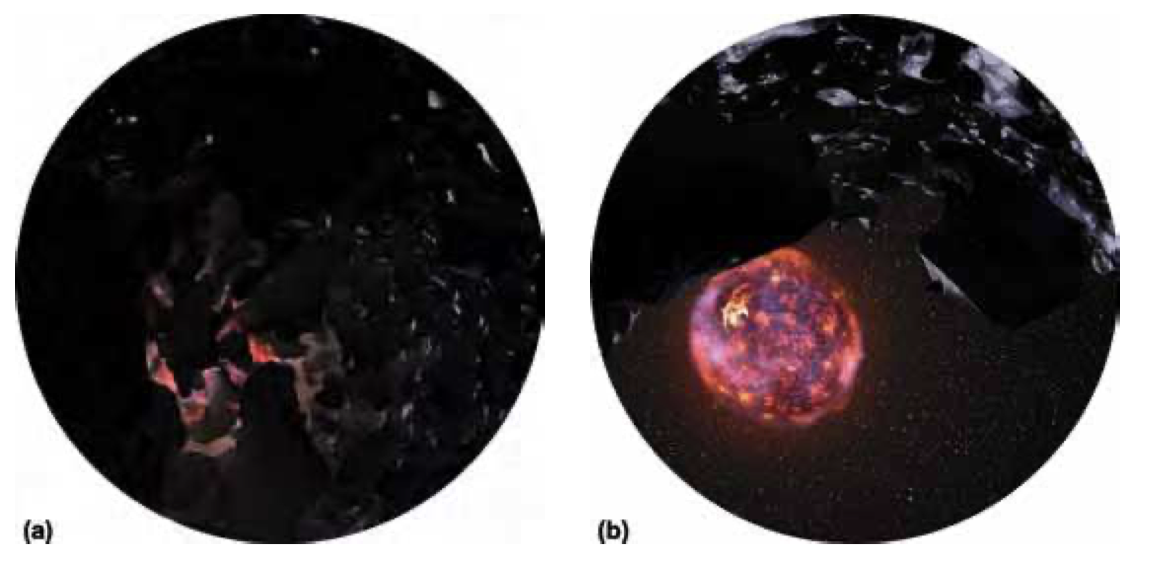
Figure 7, a-b: Stills from Realm of Light showing the (a) obscuring foreground asteroids and (b) final reveal of the red giant star. ©Softmachine
图 7:影片《光之领域》中的静帧,(a)是前景起到阻挡作用的小行星,(b)是最终揭示出来的红巨星
A way around this is a dedicated reveal. Here a foreground element or the edge of the screen eclipses something further in the background. Some combination of camera or object movement can result in the object emerging and revealing itself to surprise the audience. One such example can be found in Peter Popp’s Realm of Light: A Brief History of Life (2009), where a cluster of dark asteroids float in the foreground, obscuring something glowing in the distant background. The audience is attracted by the mysterious light which is revealed as the camera (and the audience) navigate through the floating debris field, slowly exposing a giant red star looming in the distance (Fig. 7).
解决这个问题的一种方法是专门的“揭示”(reveal)手法。将后景物体通过前景元素或银幕边缘遮挡起来,随后结合摄影机或物体的运动,让后景物体逐渐显现出来,可以给观众带来惊喜感。Peter Popp 执导的影片《光之领域:生命的简史》(Realm of Light - A Brief History of Life,2009)就应用了这一手法,片中一簇黑暗的小行星漂浮在前景中,遮挡住远处后景中发光的物体。观众被神秘的光线所吸引,当摄影机(和观众)穿越漂浮的小行星碎片场域时,远处巨大的红巨星逐渐揭示出来(图 7)。
In many cases, it may be difficult or impossible to create a single continuous shot that includes all of the scenes shot or created for a film. It will be necessary to join together a mix of disparate shots. If we follow our theory of immersive cinema, we want to minimize disruptions to the audience experience. Multiple solutions showing how this can be done can be found in Android Jones’s Samskara (2016), an art film inspired by Vedic myth and Sanskrit mantras, consisting of flight through labyrinthine computer-generated scenes populated with densely detailed imagery. Although the visuals appear to consist of one long, continuous shot, they are actually constructed from multiple scenes connected by subtle dissolves and wipes. There are edits throughout the film where an entire environment can change without the viewer immediately noticing that it is happening.
在许多情况下,很难(或无法)创建一个包含所有场景的连续镜头,需要将不同的镜头组合在一起。如果我们遵循沉浸式影院理论,则会希望尽量减少对观众体验的干扰。Android Jones 执导的影片《生生不息》(Samskara,2016)展示了多种解决方案,这是一部受吠陀神话和梵文咒语启发的艺术电影,由计算机生成的复杂图像场景组成了迷宫般的飞行体验。虽然影片的视觉效果似乎是由一个很长的连续镜头构成,但实际上是由多个场景通过细微的溶解(dissolves)和擦除(wipe)转场连接而成。电影中有许多次镜头剪辑,通过上述手法可以在观众不易察觉的情况下完全转换场景。
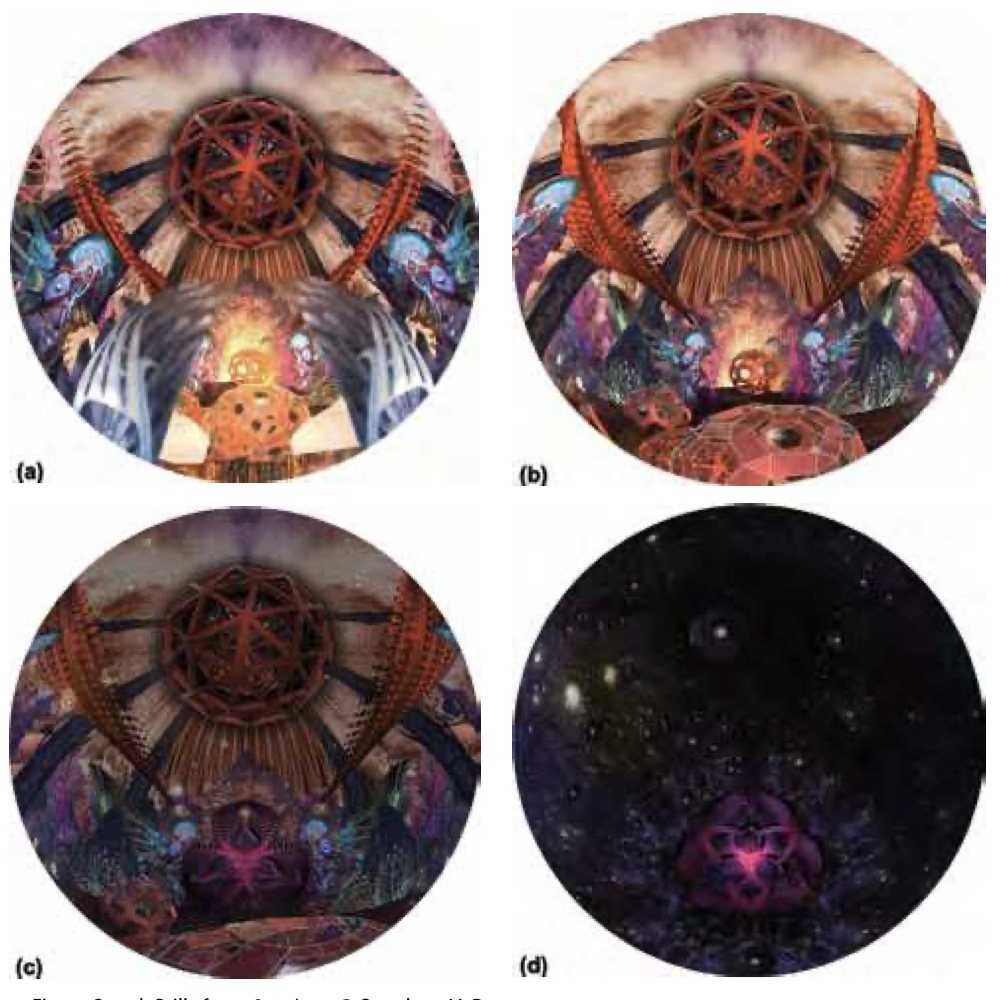
Figure 8, a-d: Stills from Samskara. © Samskara LLC.
图 8 a-d:《Samskara》中的静帧
Our first example is at the end of a scene with the camera moving past the blue-gray feather-adorned headdress of a monolithic figure, with several orange, hollow polyhedral shapes further ahead, and a dense background of texture and detail everywhere else (Fig. 8a). As the camera passes by the orange polyhedra, they and the rest of the scene darken (Fig. 8b). A deep red-magenta trilobal pattern fades up in the center of the viewer’s visual field (Fig. 8c), and grows as it animates with a rapid pulse. Since attention is drawn to this dominating feature, the viewer is less apt to notice the change elsewhere on the dome, as the original background darkens and a dissolve leads to a new starry background (Fig. 8d). The animating pattern quickly fills up the entire screen, so the new background is covered up before the viewer has a chance to reflect on it.
片中第一个例子是在一个场景结尾,摄影机经过一个巨大的蓝灰色羽毛头饰,前方有几个橙色的空心多面体形状,背景中到处都是密集的纹理和细节(图 8a)。当摄影机经过橙色多面体时,它们连同和整个场景都变暗了(图 8b)。一个深红色三叶形图案在观众的视野中央淡入(图 8c),并随着快速的脉冲动画逐渐变大。观众的注意力被吸引到这一主导特征上,不太可能注意到银幕其他部分的变化。此时原始背景变暗,溶解转场到一个新的星空背景(图 8d)。动画图案迅速填满整个银幕,因此新的背景在观众有机会反应之前就覆盖了整个画面。
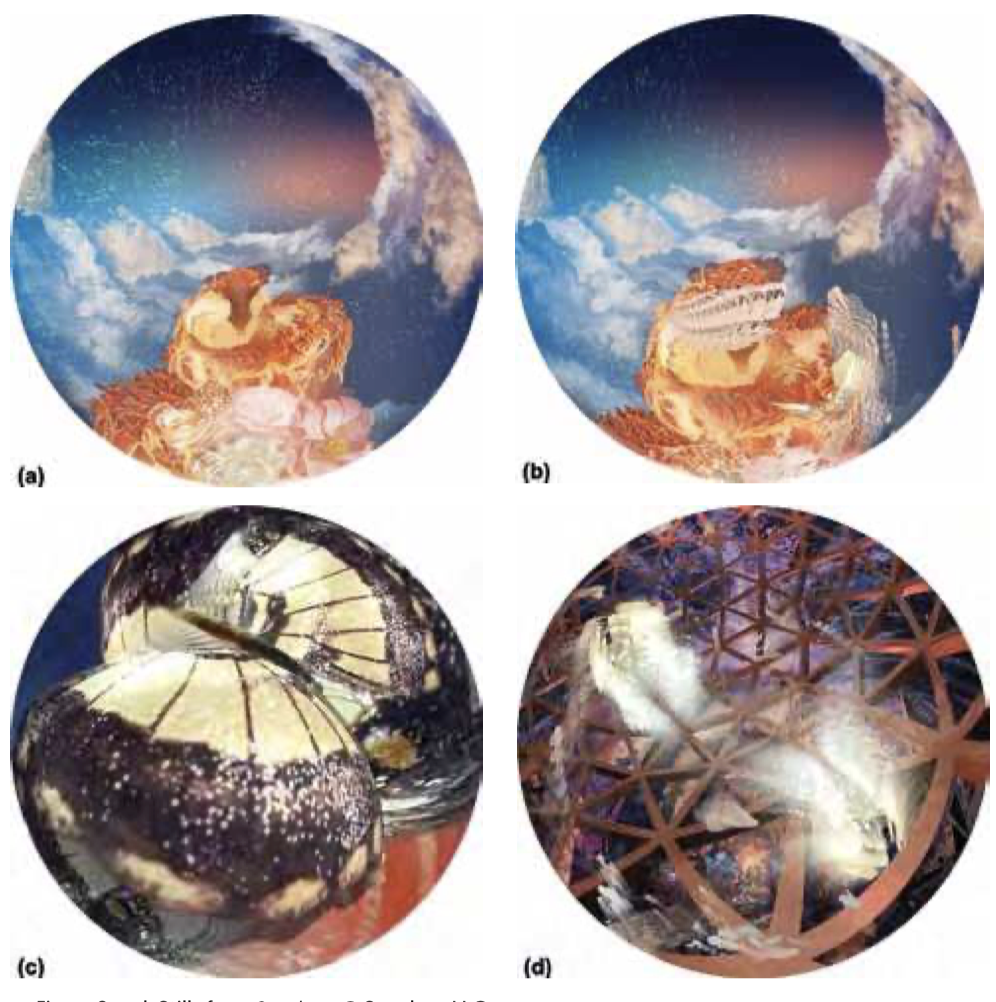
Figure 9, a-d: Stills from Samskara. © Samskara LLC.
图 9 a-d:《Samskara》中的静帧
A wipe is a film transition where a new shot replaces an old one by traveling across the frame. These tend to be noticeable if the two shots are very different looking. However, Samskara has subtle wipes by objects, where a foreground object moving through the shot helps hide the effect. In Fig. 9a, the camera is headed towards a point above the reddishorange head of another giant figure. Two butterflies appear high up and off to the left and right, meaning they are in the viewer’s peripheral vision if she is looking forward towards the direction of motion. (See the two series of overlapping wings emerging in Fig. 9b.) Other butterflies flit through the shot, but only those two get close enough to the virtual camera to momentarily fill up the entire domemaster frame (Fig. 9c). Their movement provides cover for the background scene to disappear and be replaced by a new one (Fig. 9d).
擦除是一种电影的转场手法,通过新画面在银幕上的移动来逐步替换掉旧的画面。如果两个镜头外观差异很大,这种转换往往会很明显。然而,在《生生不息》中,通过前景物体的移动实现细腻的擦除转场,可以帮助隐藏这种效应。在图 9a 中,摄影机朝着一个巨大雕像的橙红色头部上方的点前进。在高处出现了两只蝴蝶,分别位于左边和右边。如果观众朝前看,它们处于观众的周边视觉中(见图 9b 中重叠的翅膀)。其他蝴蝶在镜头中飞舞,但只有这两只蝴蝶靠近虚拟摄影机,并瞬间填满了整个球幕母版画面(图 9c)。它们的运动为背景场景的消失和新场景的替换提供了掩护(图 9d)。

Figure 10, a-e: Stills from Samskara. © Samskara LLC.
图 10 a-e:《Samskara》中的静帧
Another wipe by foreground object helps hide a jump between two diametrically opposite camera angles near the end of the film. In this scene, the camera has been pirouetting around a demonic head that is lit orange, complementary to the deep blue that dominates the shot. The environment is filled with geometrical blocks consisting of skyscraper-like shapes, including spires that resemble the Empire State Building. In Fig. 10a, a foreground element consisting of skyscraper blocks emerges from below the bottom of the frame, just to the right of the head. The camera tracks left as the foreground mass of skyscrapers grows and also moves left. The foreground skyscrapers, now grown to a triangular mass, shift to completely block our view of the towering head, with only its red tongue still not completely cut off on the left in Fig. 10b.
另一个借助前景物体运动实现擦除转场的例子,帮助隐藏了影片末尾摄影机角度完全反转的跳切。在这个场景中,摄影机围绕一个被照亮为橙色的恶魔头部旋转,背景是深蓝色,环境中充满了几何块状高楼,包括类似帝国大厦的尖塔。在图 10a 中,一个由块状摩天大楼组成的前景元素从画面底部右侧出现。摄影机向左移动,前景的块状摩天大楼也向左移动,逐渐完全遮挡住巨大的恶魔头部,只有它的红色舌头仍在左侧未被完全遮挡(图 10b)。
A wipe to a new scene starts in Fig. 10c, with the shape of the wipe matching the boundary of the triangle of skyscrapers. Notice the new background building appearing where the tongue was in Fig. 10b, and the mirrored bright clump of the Milky Way to the right of the skyscraper triangle in the incoming shot, while the bright clump from the previous shot is still visible in the back of the dome (top of the domemaster frame). The wipe grows to encompass the rest of the shot; the background building seen earlier is now revealed to be the Empire State Building, the top of it glowing blue against the Milky Way (Fig. 10d).
在图10c中,新场景的引入是通过一种与摩天大楼三角形边缘相匹配的擦除效果开始的。请注意,在图10b中舌头形状区域出现的背景建筑,以及摩天大楼三角形右侧即将进入画面的镜头中反射出的明亮银河团块。前一镜头中的明亮团块在球幕背面(即球幕母版的顶部)依然可见。随着擦除效果的扩展,它逐渐覆盖了整个画面,先前见到的背景建筑现在被揭示为帝国大厦,其顶端在银河的映衬下闪耀着蓝色的光芒(见图10d)。
As the camera continues to track left in Fig. 10e, the triangular block of buildings in the foreground moves off to the left, and we see that the camera is now on the opposite side of where it started relative to the demonic head in Fig. 10a. The position of the Milky Way has also flipped in the sky. Throughout this transition, the triangular block of skyscrapers dominates the shot with its size, central position, and motion, drawing the viewer’s attention, even as the rest of the scene around it completely changes.
当摄影机在图 10e 中继续向左移动时,前景的三角形建筑块移到左侧,我们看到相对于图 10a 中的恶魔头部,现在摄影机已经位于对面了,银河在天空中的位置也翻转了。在整个转场过程中,前景的三角形块状摩天大楼以其大小、中心位置和运动占据主导地位,吸引观众的注意力,掩盖了场景其余部分的完全改变。
Coming next 下篇预告
This ends Part I of our two part paper. In the next issue, we look further into how a fulldome director can construct shots and create compositions that are clear to the audience. We will show examples from additional films highlighting techniques to focus a viewer’s attention even when she theoretically has the freedom to look anywhere within the hemispherical display.
本文的第一部分到此结束。在下篇文章中,我们将进一步探讨全景球幕影片的导演如何设计镜头和构图,使观众能够清晰理解。我们还将展示更多影片的例子,探讨当观众理论上可以自由观看半球银幕任意位置时,如何聚焦观众注意力的技巧。
Acknowledgments 致谢
We thank Peter Popp and Android Jones for permission to use images from their films. We also thank Kathy Honda for help with our library research.
感谢 Peter Popp 和 Android Jones 允许我们使用他们电影中的静帧,感谢 Kathy Honda 帮助我们进行图书馆文献搜索。
References 参考文献
Block, B. 2008, The Visual Story, 2nd edition, Burlington, MA: Focal Press.
Bordwell, D. 2006, The Way Hollywood Tells It: Story and Style in Modern Movies, Berkeley, CA: University of California Press.
Brandt, T., Dichgans, J., & Koenig, E. 1973, “Differential effects of central versus peripheral vision on egocentric and exocentric motion perception,” Experimental Brain Research, 16(5), 476-491.
Cinemetrics 2016, https://cinemetrics.uchicago.edu/.
Crosby, E. 2007, “An Aesthetic of Wonderment: IMAX and Affect,” https://books.google.com/books/about/An_Aesthetic_of_Wonderment.html?id=o3iCAQAACAAJ&redir_esc=y.
Dragoi, V. 1997, “Visual Processing: Eye and Retina,” Neuroscience Online, University of Texas Health Science Center at Houston, https://nba.uth.tmc.edu/neuroscience/m/s2/chapter14.html.
Emmart, C. 2005, “The Powers of Ten with a Steering Wheel on the Global Visualization Superhighway,” Planetarian, 34(4), 19-26.
Heuring, D. 2008, “Batman Looms Larger,” American Cinematographer, https://www.theasc.com/ac_magazine/July2008/TheDarkKnight/page1.php.
IMAX Corp. 1999, IMAX: The 15/70 Filmmaker’s Manual.
Jones, M.G., Taylor, A., Minogue, J., Broadwell, B., Wiebe, E., & Carter, G. 2007, “Understanding Scale: Powers of Ten,” Journal of Science Education and Technology, 16(2), 191-202.
Jukic, S. 2016 April 5, “4K & Ultra HD (UHD) Resolution – Comparison of 4k vs 1080p and Everything You Need to Know,” https://4k.com/resolution/.
Katz, S. 1991, Film Directing Shot by Shot: Visualizing from Concept to Screen, Focal Press.
Lang, B. 2016 Apr 21, “Clint Eastwood Shooting ‘Sully’ Almost Entirely with Imax Cameras,” Variety, https://variety.com/2016/film/news/clint-eastwood-sullyimax-1201758250/.
LaViola Jr, J. J. 2000, “A discussion of cybersickness in virtual environments,” ACM SIGCHI Bulletin, 32(1), 47-56.
Leonardo da Vinci, 1883, The Literary Works of Leonardo da Vinci Compiled and Edited from the Original Manuscripts, J.P. Richter (ed.), London: Sampson Low, Marston, Searle & Rivington.
Lombard, M., Ditton, T. B., Grabe, M. E., & Reich, R. D. 1997, “The role of screen size in viewer responses to television fare,” Communication Reports, 10(1), 95-106.
Lombard, M., Reich, R. D., Grabe, M. E., Bracken, C. C., & Ditton, T. B. 2000, “Presence and television: The Role of Screen Size,” Human Communication Research, 26(1), 75-98.
MacGillivray, G. and Freeman, J. 1976 July, “Producing the IMAX Motion Picture: ‘To Fly,’” American Cinematographer, 57(7), 750-753, 792.
n.a. 2016 March/April, “The World’s First True8K TM Dome Theater: The Ultimate Planetarium Experience,” HMNS News, 12-15.
Nucci, M. 2005, “Reconsidering the Technological Limtations and Potential of Large Format,” Flow Journal, 10, https://www.flowjournal.org/2005/10/reconsidering-the-technological-limitations-and-potential-of-large-format/.
Nucci, M. 2010, Large Format and Mediation of the Natural World: Vision, Technology and the Sublime, PhD thesis, Rutgers, State University of New Jersey, New Brunswick, New Jersey.
Reeves, B., Lang, A., Kim, E. Y., & Tatar, D. 1999, “The effects of screen size and message content on attention and arousal,” Media Psychology, 1(1), 49-67.
Salt, B. 2009, “The shape of 1959,” New Review of Film and Television Studies, 7(4), 393-409.
Schatz, T. 1996, The Genius of the System: Hollywood Filmmaking in the Studio Era. New York: Henry Holt and Co.
Shaw, W. C., & Douglas, J. C. 1983, “IMAX® and OMNIMAX ® Theatre Design,” SMPTE Journal, 92(3), 284-290.
Shedd, B. 1989, “Exploding the Frame: Seeking a new cinematic language,” https://benshedd.com/httpbenshedd-com20081027original-exploding-the-frame-article-written-1989/.
Shedd, B. 1999, “Designing Effective Giant Screen Films,” GSTA ‘99 Pre-Conference Symposium on Giant Screen Films and Lifelong Learning, https://benshedd.com/designing-effective-giant-screen-films/.
Shedd, B. 1998, “Potentials for Expanding Scientific Literacy Through Giant Screen Films,” White Paper developoed for Emlyn Koster, Liberty Science Center, https://benshedd.com/potentials-for-expanding-scientific-literacy-through-giant-screen-films-written-1999/
Stork, M. 2011a, “Chaos Cinema Part 1,” https://vimeo.com/28016047.
Stork, M. 2011b, “Chaos Cinema Part 2,” https://vimeo.com/28016704.
Sweitzer, J. S. 2001, “Cosmic Spaceflight 101: Lessons I Learned Flying to the Edge of the Observable Universe,” Planetarian, 30(4), 4-8, 21.
Thompson, K. and Bordwell, D. 2009, Film History: An Introduction, 3/e, New York: McGraw-Hill.
Tilton, R. 1973 August, “Filming ‘Garden Isle’ in the World’s Largest Film Format,” American Cinematographer, 1026-1027. 1062-1063.
Wollen, T. 1993, “The bigger the better: From CinemaScope to Imax,” Future visions: New technologies of the screen, 10-30.
Wyatt, R. 2005, “Planetarium Paradigm Shift,” Planetarian, 34(3), 15-19.
Wyatt, R. 2014 May/June, “Planetariums as 21st Century Digital Dioramas,” Informal Learning Review, 126, 3-8.
Wyatt, R., Kennedy, T., Lapré, J., Schmitt, M. 2012, “The Making of Life: A Cosmic Story,” Planetarian, 41(1), 16-20.
Yarbus, A. L. 1967, Eye Movements and Vision, New York, NY: Plenum Press.
Yu, K.C. 2009, “Digital Planetariums for Geology and Geography Education,” Planetarian, 36(3), 6-12, 64.
Yu, K.C., Brownell, M., Schoemer, J., Neafus, D., Lucas, T. & Zager, Z. 2007, “Live Action Film Footage for an Astronomy Fulldome Show,” Planetarian, 36(1), 6–17, 86–87.
Yu, K.C., Connolly, R., Gardiner, N., Hamilton, H., Koontz, K., McConville, D., Sickler, J., & Wyatt, R. 2013, “The Worldviews Network: Digital Earth for Ecological and Resilience Education,” 8th International Symposium on Digital Earth, 26-29 Aug 2013, Kuching, Sarawak, Malaysia.
Yu, K.C., Sahami, K., Denn, G., Sahami, V., & Sessions, L. 2016, “Immersive Planetarium Visualizations for Teaching Solar System Moon Concepts to Undergraduates,” Journal of Astronomy & Earth Science Education, in press.
Yu, K.C., Sahami, K., & Dove, J. 2016, “Learning About Scale of the Solar System Using Digital Planetarium Visualizations,” American Journal of Physics, in review.
Zettl, H. 1998, Sight, Sound, Motion: Applied Media Aesthetics, 3/e. Belmont, CA: Wadsworth Publishing.
转载请注明来源。欢迎留言评论,欢迎对文章中的引用来源进行考证,欢迎指出任何有错误或不够清晰的表达。